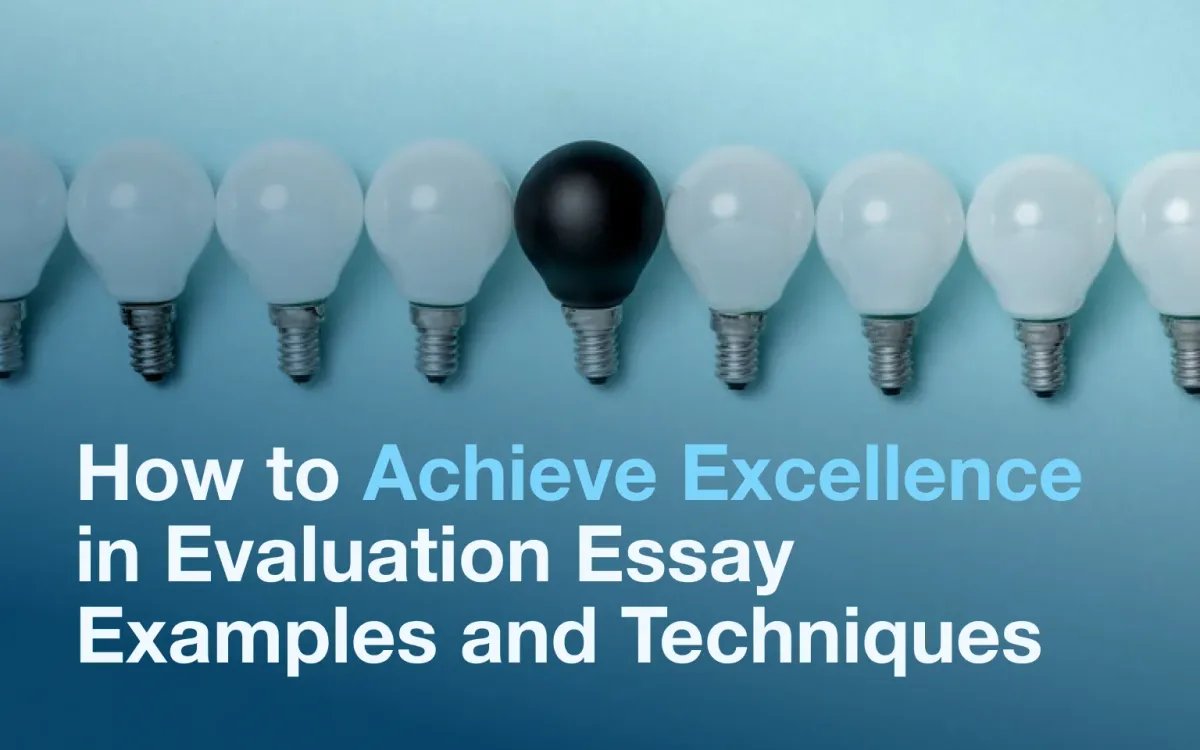How to Achieve Excellence in Evaluation Essay Examples
Learn how to write evaluation essay examples and techniques. Enhance your judgement skills and master the art of critical evaluation essay assessment.

Want to make your good evaluation essays great?
We're here to help with all the guidance and insights you need. Join us as we explore the art of critical assessment!
The main purpose of an evaluation essay is to assess things like a book, movie, restaurant, or product and offer constructive feedback. This type of writing can be serious and objective or humorous and sarcastic. Reviewing is a common academic writing style used in many fields of research, such as literature reviews or case studies in research papers.
Evaluation reports can also include analyses and critiques. For example, a critique of a scientific study examines its methods and findings, while an analysis of a novel looks at its themes, characters, and writing style. It's important to know your audience and purpose before starting an evaluation essay.
Evaluation essays are versatile and meaningful. They can educate and entertain, whether the tone is serious or funny, objective or subjective. A well-written review can engage and inform.
To learn everything about evaluation essays, including their definition, purpose, possible topics, and writing tips, keep reading.
Definition of Evaluation Essay
An evaluation essay lets the writer make a claim and give an opinion on a topic. This type of essay can help find the best choice among options or analyze a method, product, or situation. It's a common task in school and work, from online reviews, critical analysis, and writing skills, to business reports.
Unlike a descriptive essay, an evaluation essay shows the writer's judgment. But it should stay objective, meaning the opinion is based on careful examination of evidence. This is different from a persuasive essay, which tries to convince the reader to agree with the writer. An evaluation essay starts with concise facts and then draws nuanced conclusions based on those facts.
What is the Structure of an Evaluation Essay?

a. Introduction
- Hook: Start with an engaging statement that grabs the reader's attention. This could be an interesting fact, a surprising statistic, a quote, or a question related to the topic. The goal is to make the reader want to keep reading.
- Thesis Statement: Clearly state your main point or opinion about the topic. This is your evaluation or judgment. For example, if you're evaluating a restaurant, your thesis might be "This restaurant offers the best Italian food in town due to its delicious dishes, friendly service, and cozy atmosphere."
- Overview: Briefly explain what you will be evaluating and the criteria you will use. This helps the reader understand what to expect in your essay. For example, you could say, "In this essay, I will evaluate the restaurant based on the quality of the food, the level of service, and the ambiance."
b. Background Information
- Context: Give some background information about the topic you're evaluating. This helps the reader understand more about what you're discussing. For example, if you're evaluating a movie, you might mention when it was released, who directed it, and what genre it belongs to. This sets the stage for your evaluation.
- Purpose: Explain why you're doing this evaluation. Why is it important or interesting? What do you hope to achieve? For instance, you might say, "I am evaluating this movie to help readers decide if it's worth watching," or "This evaluation will show how this restaurant stands out among its competitors." This gives the reader a clear idea of the goal of your essay.
c. Criteria for Evaluation
- Define Criteria: Clearly list and describe the specific criteria you will use to evaluate the topic. These are the standards or benchmarks you'll be judging against. For example, if you're evaluating a restaurant, your criteria might include the quality of the food, the level of service, and the atmosphere. Each criterion should be clearly explained so the reader understands what you're looking for.
- Justification: Explain why you chose these particular criteria and why they are important for the evaluation. This helps the reader understand the relevance and significance of each criterion. For instance, you might say, "The quality of the food is crucial because it directly affects the dining experience," or "Service is important because it influences how welcome and comfortable customers feel." This explanation shows that your evaluation is based on thoughtful and relevant standards.
d. Body Paragraphs
Criterion 1: Discuss the first criterion.
- Evidence: Provide specific evidence and examples that support your evaluation based on this criterion. For instance, if the first criterion is the quality of food at a restaurant, you might describe a specific dish you tried, its taste, presentation, and ingredients.
- Analysis: Explain how this evidence supports your evaluation. Discuss whether the food met your expectations and why. For example, you could say, "The pasta was cooked perfectly, with a rich and flavorful sauce, which shows that the restaurant maintains high culinary standards."
Criterion 2: Discuss the second criterion.
- Evidence: Again, give specific evidence and examples that relate to this criterion. If the second criterion is service, you might talk about how the staff treated you, how quickly your order was taken, and how attentive they were.
- Analysis: Analyze this evidence to explain how the service met or didn't meet your standards. For example, "The waitstaff were friendly and prompt, ensuring our dining experience was enjoyable and stress-free."
(Repeat for additional criteria as needed)
Criterion 3: Discuss another criterion, such as the atmosphere of the restaurant.
- Evidence: Describe the ambiance, décor, and overall feel of the place.
- Analysis: Explain how these elements contribute to or detract from the dining experience. For example, "The cozy, well-decorated interior made for a pleasant dining environment, enhancing our overall experience."
Continue this pattern for each additional criterion you have. Make sure each paragraph focuses on one criterion, provides evidence, and analyzes that evidence to support your evaluation. This structured approach helps the reader clearly understand your assessment and the reasons behind it.
e. Counterarguments (Optional)
- Address Counterarguments: Recognize and mention any potential counterarguments or different opinions that others might have about your evaluation. This shows that you have considered other perspectives. For example, if some people think a restaurant is overrated, you could mention this viewpoint to show you understand that not everyone agrees with your evaluation.
- Refutation: Provide evidence and reasoning to explain why these counterarguments are not as strong as your evaluation. Use facts and examples to support your refutation. For instance, you could say, "While some people believe the restaurant is overrated, my experience showed that the quality of the food and service was consistently high, as evidenced by the perfectly cooked dishes and attentive waitstaff." This helps to strengthen your argument by showing that you have thought about other views and have reasons for disagreeing with them.
How to Write a Good Evaluation Essay?

To write an effective evaluation essay, follow these simple tips:
1. Select a Topic
When you're deciding on a topic for your evaluation essay, it's important to select something that not only interests you but also offers educational value. This ensures that you'll be engaged in researching and writing about the subject. Additionally, you should verify that there's a sufficient amount of information and material available to cover all aspects of the topic thoroughly in your essay. This preparation helps you create a well-rounded evaluation that is both informative and compelling to your readers.
2. Draft an Evaluation Essay Outline
Drafting an evaluation essay outline is a crucial step advised by experts to organize your ideas and ensure your writing is clear and coherent. It serves as a roadmap for your essay, making it easier to see how each part fits together before you start writing.
An outline is flexible, allowing you to rearrange or adjust your ideas more easily than if you had already written the entire essay. It helps you decide what information is essential and what can be left out to keep your essay focused and effective.
Skipping the outline can lead to more work later on because you may need to go back and reorganize or rewrite sections to improve clarity and structure. Taking the time to create a thorough outline saves time and effort in the long run, helping you produce a well-organized and polished evaluation essay.
3. Components of an Evaluation Essay Outline:
a. Introduction
- The introduction is the first impression readers get, so make it engaging.
- Start with a compelling hook to capture interest.
- Provide background information for better understanding.
- Write a clear thesis statement that outlines the main goal of your evaluation.
b. Body Section
- The body usually has three paragraphs, each with related ideas that flow smoothly.
- Start each paragraph with a sentence presenting your view on the topic.
- Support your view with strong arguments.
- Show impartiality by presenting a well-rounded argument.
- Compare the subject to another topic to highlight its strengths and weaknesses.
- Evaluate the topic from different angles, using both positive and critical thinking.
c. Conclusion
- The conclusion is your last chance to convince the reader.
- Summarize the main points and arguments from the body.
- Restate your thesis and provide evidence to support it.
- End with a convincing argument to persuade the reader of your evaluation.
4. Review and Proofread
After completing your essay, it's important to dedicate time to editing and proofreading it thoroughly. This process involves reviewing your writing multiple times to identify and correct any grammatical errors, awkward phrasing, or inconsistencies.
By carefully reading through your essay, you ensure that it flows smoothly and effectively communicates your ideas. This final step is essential for polishing your work and presenting a polished, error-free evaluation essay to your audience.
Evaluation Essay Examples

a. Evaluation of a Movie
When evaluating a movie, you delve into various aspects that contribute to its overall quality and impact. For example, let's consider analyzing a recent film like "Inception":
Storytelling: Assess how well the narrative unfolds, the clarity of the plot, and whether it keeps the audience engaged from start to finish. Discuss if the story is original or derivative, and how effectively it builds tension and resolves conflicts.
Acting: Evaluate the performances of the lead actors and supporting cast. Discuss their ability to portray characters convincingly, evoke emotions, and contribute to the believability of the story.
Cinematography: Analyze the visual elements such as camera angles, lighting, and use of color. Evaluate how these elements enhance the storytelling, create mood, and contribute to the overall aesthetic appeal of the film.
Impact on the Audience: Consider how the movie resonates with its audience. Discuss its entertainment value, emotional impact, and whether it prompts reflection or discussion after viewing. Evaluate how well it achieves its intended goals, whether it's to entertain, inform, provoke thought, or inspire.
Example:
"Inception," directed by Christopher Nolan, is a captivating film that challenges the audience's perception of reality through its intricate storytelling and mind-bending plot twists. The narrative seamlessly blends elements of science fiction with psychological thriller, keeping viewers on the edge of their seats throughout. Leonardo DiCaprio's portrayal of Dom Cobb, a troubled thief who enters people's dreams to steal secrets, is compelling and emotionally charged, adding depth to the character dynamics. The film's cinematography, marked by stunning visual effects and innovative use of practical effects, creates a surreal and immersive experience. Overall, "Inception" leaves a lasting impact on its audience by exploring themes of guilt, redemption, and the power of dreams, making it a thought-provoking and visually stunning cinematic masterpiece.
b. Evaluation of a Restaurant
When evaluating a restaurant, several factors contribute to the overall dining experience. Let's consider an example of assessing a local restaurant named "Gourmet Delights":
Food Quality: Evaluate the taste, freshness, and presentation of dishes served. Discuss whether the ingredients are of high quality and if the flavors are well-balanced. Consider if the menu offers a variety that caters to different tastes and dietary preferences.
Service Efficiency: Assess the attentiveness and professionalism of the staff. Evaluate how quickly orders are taken and served, as well as the staff's knowledge of the menu and ability to make recommendations. Consider if the service enhances or detracts from the dining experience.
Ambiance: Analyze the atmosphere and decor of the restaurant. Evaluate factors such as lighting, seating comfort, cleanliness, and overall aesthetic appeal. Consider if the ambiance matches the restaurant's theme and if it contributes to a pleasant dining environment.
Overall Dining Experience: Reflect on the entire dining experience, from arrival to departure. Consider factors like wait times, noise levels, and the overall atmosphere created by other diners. Assess whether the restaurant delivers on its promises and meets expectations set by its reputation or marketing.
Example:
"Gourmet Delights," a cozy bistro located in downtown, offers a sophisticated dining experience with a focus on locally sourced ingredients and seasonal menus. The food quality is commendable, with dishes like the grilled salmon served with a citrus herb sauce showcasing fresh flavors and meticulous preparation. However, the service efficiency could be improved, as wait times for both taking orders and delivering meals were slightly longer than expected during peak hours.
The ambiance of "Gourmet Delights" is inviting, with soft lighting and comfortable seating arrangements contributing to a relaxed dining atmosphere. The decor, featuring modern art pieces and warm wooden accents, enhances the restaurant's upscale yet welcoming vibe. However, noise levels could occasionally disrupt the dining experience, particularly when the restaurant is busy.
Overall, "Gourmet Delights" provides a memorable dining experience with its culinary offerings and pleasant ambiance. To further enhance customer satisfaction, the restaurant could benefit from refining service efficiency during busy periods and ensuring consistent noise management. These adjustments would elevate the overall dining experience and maintain "Gourmet Delights" as a favorite spot for both casual diners and food enthusiasts alike.
c. Evaluation of a Website
When evaluating a website, several key factors contribute to its usability and effectiveness. Let's consider an example of assessing a popular travel website named "Travel Seeker":
User Interface: Evaluate the design and layout of the website. Discuss whether it is visually appealing, intuitive to navigate, and user-friendly. Consider factors such as color scheme, font choices, and the overall aesthetic appeal that enhances the user experience.
Navigation: Assess how easy it is to find information on the website. Evaluate the menu structure, search functionality, and the clarity of navigation paths. Discuss whether users can easily navigate between different sections and find what they are looking for without confusion.
Content Relevance: Critically analyze the quality and relevance of the content provided on the website. Evaluate if the information is accurate, up-to-date, and useful to the target audience. Consider how well the content addresses the needs and interests of users seeking travel information.
Functionality: Evaluate the functionality of interactive features such as booking tools, interactive maps, and customer support options. Assess if these features work smoothly and contribute to a seamless user experience. Discuss any technical issues or glitches that may hinder user interaction.
Meeting the Needs of the Target Audience: Reflect on how well the website meets the specific needs and expectations of its target audience, such as travelers looking for destination guides, flight bookings, or hotel reservations. Consider if the website effectively serves different user segments and their preferences.
Example:
"Travel Seeker," a popular travel website, offers a comprehensive platform for travelers seeking information on destinations, accommodations, and travel tips. The user interface is visually appealing, with a clean layout and a soothing color scheme that enhances readability. However, the navigation could be more intuitive, especially when searching for specific destinations or filtering search results by preferences such as budget or travel dates.
The content on "Travel Seeker" is extensive, providing detailed destination guides, hotel reviews, and travel articles. However, some content sections lack updates, leading to outdated information that may impact user trust and satisfaction.
Functionality-wise, the booking tools for flights and hotels work efficiently, allowing users to make reservations easily. However, the interactive maps could benefit from additional features such as local attractions and transportation options to enhance trip planning.
Overall, "Travel Seeker" effectively caters to the needs of travelers by providing valuable travel information and booking services. To improve user experience, the website could focus on enhancing navigation usability, updating content regularly, and adding more interactive features that facilitate seamless travel planning and booking. These enhancements would further solidify "Travel Seeker" as a preferred choice among travel enthusiasts seeking reliable and user-friendly travel resources online.
Conclusion
Effective evaluation essays require clear criteria and thorough analysis. Choose topics that interest you and offer ample material for discussion.
Outline your essay to organize your thoughts and ensure a logical flow. Use specific evidence to support your evaluations and consider counterarguments.
Conclude by summarizing your main points and reinforcing your evaluation's impact. By following these steps, you can create compelling evaluation essays that are informative and persuasive.
Frequently Asked Questions
1. How do you write an evaluation essay?
To write an evaluation essay, first choose a topic you can assess, like a movie or restaurant. Start with an introduction that hooks your reader and states your main evaluation point (thesis). In the body paragraphs, discuss criteria like quality or service, provide evidence, and analyze how well the subject meets those criteria. Address counterarguments if needed. Conclude by summarizing your evaluation and its significance.
2. What is an example of evaluation?
An example of evaluation could be assessing a smartphone based on its design, performance, battery life, and user interface. You'd analyze each aspect, provide evidence (like comparing it to other models), and form a judgment about whether it's a good buy.
3. How to start an evaluation example?
Start an evaluation by introducing your subject and its significance. Use a hook like an interesting fact or quote to grab attention. Provide background information to help readers understand the context. End your introduction with a clear thesis statement that states your evaluation criteria and main point.
4. How do I write my evaluation?
Write your evaluation by organizing your thoughts into an outline first. Start with an introduction and body of the essay that hooks readers and states your thesis. In the body paragraphs, discuss each evaluation criterion, provide evidence (like examples or data), and analyze how well the subject meets your standards. Conclude by summarizing your evaluation and its implications.
5. What are examples of evaluation essay topics?
Examples of evaluation essay topics include assessing a new restaurant for food quality and service, evaluating a recent movie for its plot and acting, analyzing a website's user interface and functionality, or critiquing a book for its themes and writing style. This topic essay aims to allow you to discuss criteria and provide evidence to support your evaluation.



